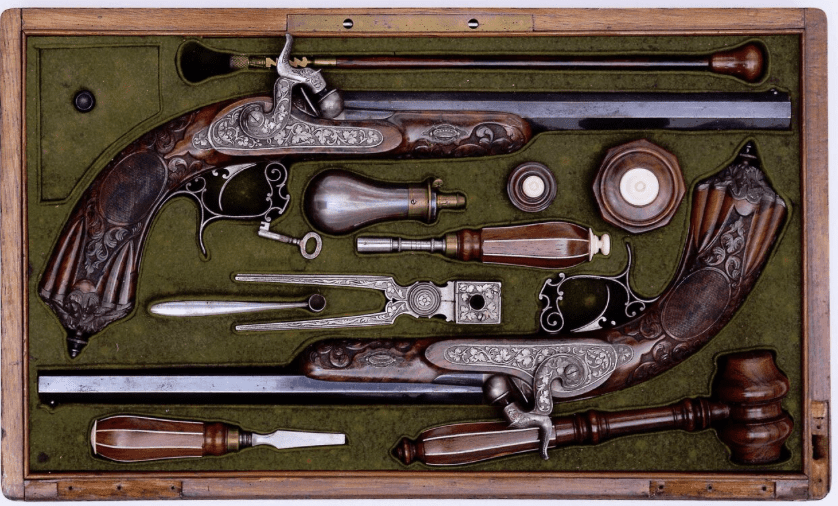If I mention the terms racing and guns, it may conjure the image of a NASCAR fan out in the woods hunting. However, in this particular scenario, those two terms represent a high-end pair of French cased pistols.
This pair of muzzleloading percussion target pistols was made by Gastinne-Renette of Paris, France sometime between 1840 and 1855. This gunmaker, founded by Renette who partnered with former Napoleon officer Gastinne, was the supplier of France during Napoleon III’s reign.
They were associated with high-end product and survived in some fashion from 1812 to 2003. This pair of .49 caliber pistols was presented to Count R. D’Herouville, a Second Lieutenant of the French 16th Dragoon Regiment. However, these firearms were not awarded as merit for his military accomplishments, rather for serving as jockey, riding horses Orphelin and Mishap at the Saumur Races.

For more information, visit centerofthewest.org





Purty.
Dualing Pistols?
No, probably not. As the article labels them ‘target’ pistols, I assume that they are rifled; Rifling in a dueling pistol was considered ungentlemanly at the time.
These also are more ornate than the usual ‘dueler’ pair, those guns tending to be rather plain, and the article states that they were awarded to a Count–so, they are a very expensive custom pair of ‘gentleman’s pistols’ for a noble’s sporting use, made by probably THE premier French maker of the time.
Late in the game on this pair, but I thought this should be clarified in case someone else comes across this post. Dueling codes varied from place to place, so readily acceptable weapons in one country were sometimes considered unsporting in other places. Dueling pistols with rifling were actually the norm in Continental Europe for much of the 1800s. The English and Americans preferred smoothbores most of the time, but even they sometimes employed rifling or hidden “scratch rifling.” Technically, any weapons could be agreed upon for a duel. There are formal duels fought with Kentucky rifles for example. On the continent, it can be hard to tell dueling and target pistols apart since they evolved together, but adjustable rear sights were common on target pistols but unacceptable on dueling pistols.
There are two of them, so, yea, dual pistols I guess.
Ah. Missed the pun. Got all testicle, instead. Sorry.
Sure don’t make em’ like they used to.
+1
There is a real art to firearms manufacturing of that era. I think the craftsmanship is sometimes lost it our utilitarian world of mass production.
The craftsmanship still exists. You just don’t see it in any of the mass-marketed gun rags.
Try checking out a copy of Double Gun Journal, and the American Custom Gunmakers Guild magazines.
Recently saw a video of the Holland & Holland factory.
They were fitting lockwork, and to get them to fit precisely, the smith put the work in the flame of a smoky oil lamp to coat it with soot, and then put the parts together, saw where the high spots were, and carefully filed them down.
I imagine he did that hundreds of times to just that one part. There were some guys in that video who were quite young, H & H must practice apprenticeship.
It sure would be nice if American gunmakers would value that philosophy…
The oil lamp soot fitting is at the 4:00 mark…
https://www.youtube.com/watch?v=qUXoNUzAyvk
I have a smoke pot on my bench.
I also use a Sharpie marker, Dykem and other methods to fit up parts.
The soot-fit method gives you the greatest control over tight fits.
GeoffPR “It sure would be nice if American gunmakers would value that philosophy…”
The problem isn’t the supplier, it’s the customer. People either don’t recognize, or don’t value, quality. For instance, I adore flintlocks. The wood alone, and I mean the unshaped, unfinished board, on my flinters costs more than most modern guns people buy. Very of few us are willing to pay that.
I would imagine they were dueling pistols since they are an identical set.
Whether anyone ever intended to use them for dueling is another matter.
Any gent who considereal himself well-to-do would have probably owned a set.
Ashley, if possible, if known, could you include what those antiques cost when new, and what that number would be corrected to today’s dollars?
It would be nice to see the investment people made when buying them at the time…
“If I mention the terms racing and guns, it may conjure the image of a NASCAR fan out in the woods hunting. “
Pretty much the very last image I conjure is “NASCAR” when the word “racing” is mentioned. Especially in context of viewing a pair of presentation pistols.
NASCAR ceased being about racing when they turned into pussies and required restrictor plates.
NASCAR was never about “racing”, only about having trash drive trash around an oval for advert dollars. I guess since there’s technically a ‘finish line’ there’s a ‘race’ but it ain’t no Group B rally, so I have always seen it as a horrid steaming pile of flaming joke at most generous.
(since it’s current) It’s comparing a $350 plastic Glock popgun to an H&H drilling.
NAPCAR has always been the snooze-tacular Dane Cook of motorsports….
So what qualifies as righteous motorsport racing in your book, then?
F1, the billionaire’s sport? Indy Racing League? CART?
When it comes down to a battle of technology, it’s kinda hard to beat the Reno National Championship Air Races, where you can see toys like this:
https://www.youtube.com/watch?v=noinWeUHgDk
F1, the billionaire’s sport? Indy Racing League? CART?”
Throw in Group B Rally and classic ’30s Gran Prix, and you’re getting close. I’m sorry, a bunch of inbred mooks driving a roundy-round in a stone-age-tech POS is joke racing as far as I’m concerned. Yes, it’s amusing to watch guys “race” lawnmowers and barstools, but it’s still a fvckin’ joke.
F1 got 1HP/cc in the ’80s. Nobody in any series is allowed to “race” anymore, but at least F1 they’re allowed some small license. NASCAR and INDY should have regular lap times pushing 300 MPH if it was actually “real” racing. Not to mention the ‘drag’ garbage. Were they allowed to use the best tech and actually, you know, race, the trap speeds would have been in the 400s long ago.
Actual racing is pretty much dead, all we have is faint echos.
Comments are closed.